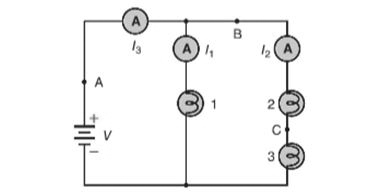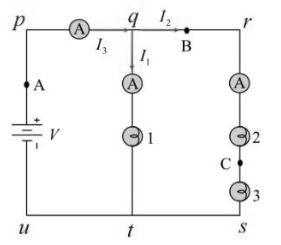
the current through the bulb 2.
Answer to Problem 30SSC
The current flowing through the bulb 2 is 0.6 A.
Explanation of Solution
Given:
Four resistors are connected.
The circuit diagram is

Formula used:
Kirchhoff’s law can be expressed as
Here,
Calculation:
Kirchhoff’s first rule states that the sum of incoming current towards a junction in a circuit is equal to the sum of outgoing current away from that junction.
The circuit diagram is as shown below

In the above circuit, 1,2 and 3 are the three bulbs.
Rearrange the equation (1) for
Substitute the values in equation (2)
Conclusion:
Hence, the current flowing through the bulb 2 is 0.6 A.
Chapter 23 Solutions
Glencoe Physics: Principles and Problems, Student Edition
Additional Science Textbook Solutions
Cosmic Perspective Fundamentals
Chemistry: Structure and Properties (2nd Edition)
Human Anatomy & Physiology (2nd Edition)
Anatomy & Physiology (6th Edition)
Chemistry: A Molecular Approach (4th Edition)
Genetic Analysis: An Integrated Approach (3rd Edition)
- In each of the following, solve the problem stated. Express your answers in three significant figures. No unit is considered incorrect. 1. For the circuit shown, determine all the currents in each branch using Kirchhoff's Laws. (3 points) 6 5V 2 B C 4 A www 6 VT ww T10 V F E 2. Compute for the total power dissipation of the circuit in previous item. (1 point) 3. Use Maxwell's Mesh to find Ix and VAB for the circuit shown. (3 points) Ix 50 V 20 ww 21x B 4. Calculate all the currents in each branch using Maxwell's Mesh for the circuit shown. (3 points) www 5ი 10 24V 2A 2002 36Varrow_forwardIf the mass of substance (1 kg), initial temperature (125˚C), the final temperature (175˚C) and the total volume of a closed container (1 m3) remains constant in two experiments, but one experiment is done with water ( ) and the other is done with nitrogen ( ). What is the difference in the change in pressure between water and nitrogen?arrow_forwardUsing the simplified energy balance in Equation 1, suppose there is heat transfer of 40.00 J to a system, while the system does 10.00 J of work. Later, there is heat transfer of 25.00 J out of the system while 4.00 J of work is done on the system. What is the net change in internal energy of the system?arrow_forward
- You pour a litre (1 kg) of 25.0˚C water into a 0.500 kg aluminium pan off the stove, but has previously been heated so it starts with a temperature of 120˚C. What is the temperature when the water and the pan reach thermal equilibrium (i.e., what is the temperature of both objects when they reach the same temperature)? Assume that the pan is placed on an insulated pad and a negligible amount of water boils off.arrow_forwardA golf club hits a golf ball and the golf ball’s flight reaches a maximum height of 5.48 m. Calculate the momentum of the golf ball at the maximum height if the mass of the golf ball is 0.459 kg.arrow_forward• Superposition Theorem • Thevenin's and Norton's Theorem 1. Find the unknown voltage V₁, unknown resistances R1 and R2, and currents flowing through R1 and R2 for the circuit shown below using Superposition Theorem. 40 V + R₁₂ w B C ♥16A 10A www 4A F ww 2 E Ꭰ 2. Use Thevenin's Theorem to find the current flowing in 3-ohm resistor and its power dissipation from the circuit shown in the right. + 3. Use Norton's Theorem for the same instruction as for No. 2. 8 V A www 202 B wwww 20 Ω 10 V + 302 202 www C - 12 V 502 www.arrow_forward
- Fill in blanksarrow_forwardA rock is dropped from a height of 2.00 m. Determine the velocity of the rock just before it hits the ground. If the momentum of the rock just before hitting the ground is 14.0 kg m/s, what is the mass of the rock? Is the collision between the rock and the ground elastic or inelastic? Explain.arrow_forwardDescribe how the momentum of a single ball changes as it free falls from a height of approximately 1 m, collides with a hard floor, and rebounds.arrow_forward
- • Nature of Resistance Temperature-Resistance Relationship Ohm's Law, Energy and Power Kirchhoff's Law • • Maxwell's Mesh Analysis 1. The steel of the third rail of a railway system has a resistivity of 21.4 μ-cm. If its cross-sectional area is 8.2 in², calculate the resistance per mile of rail, neglecting the effect of joints between sections. (1 point) 2. An incandescent lamp has a tungsten filament whose resistance is 96 at its operating temperature of 2900°C. Calculate the filament resistance when the lamp is disconnected from the electric source, under which condition its temperature is 24°C. (Use do = 0.0045 02/°C for tungsten) (1 point) 3. For the circuit shown, find the following: 50 V 602 10 V 702 a. the value of resistor R. (1 point) b. the equivalent resistance with respect to the 50-V source. (1 point) 4. For the circuit shown, determine all the currents in each branch using Kirchhoff's Laws. (3 points) A 5V 2 В -ний C 4 6 VT ww F E 5. Use Maxwell's Mesh to find I, and VAB…arrow_forwardFor items 8-9, refer to the problem below. Find all the currents flowing in every resistor, power dissipation in every resistor and the total power of the circuit shown at the right using... 8. Kirchhoff's Laws (5 pts) 9. Maxwell's Mesh Analysis (5 pts) A 8 V 10 V B + 20 Ω 3Ω 202 wwww C wwww 202 + 50 www 12 Varrow_forward• Nature of Resistance Temperature-Resistance Relationship Ohm's Law, Energy and Power Kirchhoff's Law • Maxwell's Mesh Analysis 1. A coil of copper wire (p = 10.37 2-cmil/ft) has a length of 600 ft. What is the length of an aluminum conductor (p 17 cmil/ft), if its cross-sectional area and resistance are the same as those of the copper coil? (Hint: Look for conversion of inches to mils and square inches to square foot. Include it in your solution.) (1 pt) 2. The copper field winding of an electric machine has a resistance of 46 at temperature of 22°C. What will be its resistance at 75°C? (Use do = 0.00427 /°C for copper) (1 pt) 3. The resistivity of a copper rod 50 ft long and 0.25 inch in diameter is 1.76 μ at 20°C. What is its resistance at - 20°C? (1 pt) 4. When two resistors A and B are connected in series, the total resistance is 36 2. When connected in parallel, the total resistance is 8 Q. What is the ratio of the resistance RA to resistance RB? Assume RA < RB. (1 pt) 5. The…arrow_forward
 College PhysicsPhysicsISBN:9781305952300Author:Raymond A. Serway, Chris VuillePublisher:Cengage Learning
College PhysicsPhysicsISBN:9781305952300Author:Raymond A. Serway, Chris VuillePublisher:Cengage Learning University Physics (14th Edition)PhysicsISBN:9780133969290Author:Hugh D. Young, Roger A. FreedmanPublisher:PEARSON
University Physics (14th Edition)PhysicsISBN:9780133969290Author:Hugh D. Young, Roger A. FreedmanPublisher:PEARSON Introduction To Quantum MechanicsPhysicsISBN:9781107189638Author:Griffiths, David J., Schroeter, Darrell F.Publisher:Cambridge University Press
Introduction To Quantum MechanicsPhysicsISBN:9781107189638Author:Griffiths, David J., Schroeter, Darrell F.Publisher:Cambridge University Press Physics for Scientists and EngineersPhysicsISBN:9781337553278Author:Raymond A. Serway, John W. JewettPublisher:Cengage Learning
Physics for Scientists and EngineersPhysicsISBN:9781337553278Author:Raymond A. Serway, John W. JewettPublisher:Cengage Learning Lecture- Tutorials for Introductory AstronomyPhysicsISBN:9780321820464Author:Edward E. Prather, Tim P. Slater, Jeff P. Adams, Gina BrissendenPublisher:Addison-Wesley
Lecture- Tutorials for Introductory AstronomyPhysicsISBN:9780321820464Author:Edward E. Prather, Tim P. Slater, Jeff P. Adams, Gina BrissendenPublisher:Addison-Wesley College Physics: A Strategic Approach (4th Editio...PhysicsISBN:9780134609034Author:Randall D. Knight (Professor Emeritus), Brian Jones, Stuart FieldPublisher:PEARSON
College Physics: A Strategic Approach (4th Editio...PhysicsISBN:9780134609034Author:Randall D. Knight (Professor Emeritus), Brian Jones, Stuart FieldPublisher:PEARSON





